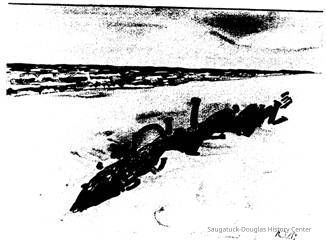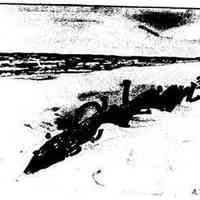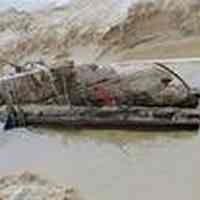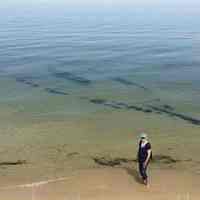George F. Foster wreck

2023.50.114
SDHS NL InsertsNauticalShipwrecks1840 Shipbuilding
Winthers, Sally
Digital data in CatalogIt
Van Tubbergen, Kathy
A Bit of Saugatuck on a Northern Shore (Sometimes bits of Saugatuck area history turn up in the strangest places. Area artist Kathy Van Tubbergen palmed an interesting artifact on the beach near Ludington and inquired about its origin. She received this reply from Alan V Wernette of the Department of Natural Resources interpretive staff which linked the bit of wood and metal to a boat built in Saugatuck) Ludington State Park lies on Michigan's Lake Michigan share roughly 1 ?5 miles north-northeast of Chicago. The park offers miles of swimming beach backed by sand dunes and the magnificent Big Sable Point Lighthouse, one of 121 lighthouses in Michigan the lighthouse lies near the northern end of the park and is open to the public during the summer months. there is no public parking at the lighthouse and access is gained by walking 1 '/2 miles from the main parking lot, either along the beach or a two-track road behind the dunes. the latter is frequently used by bicyclists. The most interesting (or at least attractive) route is along the beach. About halfway along the beach between the parking lot and the lighthouse, lie the barely visible wooden remains of a shipwreck. During times of normal water, levels the wreckage lies in the surf. In the spring of 200 and with near-record low water levels, it lay well above and behind the waterline. The regularization of public visitation to the lighthouse in 2002 following its transfer to the State of Michigan, greatly increased foot traffic past the wreck. In the summer of 2003, the Office of Education and Outreach, Michigan Department of Natural Resources, applied for funding through the coastal Management program for, among other activities the creation of an education interpretive panel for the wreck. At that time the identity of the wrecked vessel was unknown and the Office of the State Archaeologist, Michigan Historical Center, volunteered its assistance in exposing and, hopefully, identifying the wreck. On April 19, staff members from the Office of the State Archaeologist, Thunder Bay National Marine Sanctuary and Underwater Preserve (Pat Labadie, a former curator of the S. S. Keewatin) and Ludington State Park spend the day digging, pumping, and sketching and produced enough information to identify the wreck as the George F. Foster to a high level of certainty. George F. Foster was a two-malted schooner built at Newark (now Saugatuck), Michigan in 1852. Headed from Grand Haven to Chicago, the ship with its load of lumber was blown off course and wrecked at Big Sable Point in October of 1872. Armed with that information, department interpreter Earl Wolf quickly put together the interpretive panel (which cost only $90 to fabricate) and placed it just to the side of the wreck. Annually approximately 35,000 visitors pass by the wreck and its interpretive panel. According to Earl, the walk up the beach to the lighthouse is usually done by family groups rather than individuals. Alan Wernette, who does the interpreter-led hikes along the beach reports that there is an audible hum of excitement when the youngsters are told that they will be seeing a shipwreck. Disney-fueled expectations of a large wooded vessel with tattered sails inevitably succumb to disappointment when confronted by the reality of the humble remains. Nevertheless, it is not long after having some of the subtler aspects of the site pointed out that interest returns. The wreck poking out of the sand evokes a sense of discovery and a range of questions, not all of which can be answered by the limited information on the panel. they want to know more about its history, what became of the crew, what will happen to it when the lake returns to its normal levels. It is the immediacy of the presence of physical remains that excites the curiosity. It is unlikely that a similarly positive response would be evoked by a panel that presented only generalities about the known or probable presence of unseen submerged wrecks. The investment of a relatively small amount of time and money appears to have had a major impact on the public's appreciate of this beached wreck. (According to, "Built on the Banks of the Kalamazoo" a compendium of boats constructed along the Kalamazoo River: The schooner George F. Foster, (registry number 10195) was built by James Randall, possibly near the mouth of the river. One insurance listing gives the place of construction as Kalamazoo (the original name for Saugatuck), another notes that it was built at Newark (the name used by Saugatuck Township from 183b to 1861 ). She was first registered at Chicago May 27, at 123.9 tons with the owner listed as F. Meadowcraft, and the master as G. McIntosh. In 1865 she had a close call north of Ludington and was first thought to be a total loss, but she was later put back in service. There was no loss of life, but cargo valued at $5,000 was lost, and the vessel was badly damaged. In 1868 she was rated at 93.05 tons and registered at Chicago.)
This information was OCR text scanned from SDHS newsletter supplements. Binders of original paper copies are in the SDHC reference library.
https://www.mlive.com/news/muskegon/2015/07/shipwreck_in_ludington_shallow.html MUSKEGON Shipwreck in Ludington shallows possibly Saugatuck schooner, archaeologist says Published: Jul. 30, 2015, 6:17 p.m. By Stephen Kloosterman | [email protected] LUDINGTON, MI - A wooden hulk showing up in the shallows of Lake Michigan near Ludington is no surprise to one Michigan official. The shape of the ship could be clearly distinguished on Wednesday, July 29, in the shallows of the Nordhouse Dunes Wilderness Area north of Ludington -- roughly a mile's walk south from the Nurnburg Road parking area. "About 10 years ago I visited a shipwreck then on the shoreline north of Ludington," Michigan's Maritime Archaeologist Wayne Lusardi said in a written statement Wednesday. "With higher lake levels over the last few years I suspect that the same wreck is now inundated in very shallow water near shore." Lusardi said the site he visited measured 94.5 feet in overall length - the size of hundreds of smaller schooners that were built on the Great Lakes between the 1840s and 1870s. "Most of these schooners were rigged with two masts, could carry about 150 tons of cargo, principally lumber, grain, salt or coal, and were manned by a crew of four or five," Lusardi said. "Much of the fleet operating in or around Ludington was involved in carrying lumber to Chicago from ports in Western Michigan." Jim Fey, a self-described "nautical nut" and board member of the Mason County Historical Society, said he planned to visit the site this weekend and take measurements of the wreck. "We can narrow it down to a few ships, I think," Fey said. The work is difficult because many ships were lost in waters near Big Sable point. "It's a treacherous area -- there are a lot of sand bars," Fey said. The shipwreck recently seen in the shallows could be one of many schooners lost in that area -- one example is the Lizzie Doak, which ran aground there in 1892. But Lusardi said it could prove to be The George F. Foster, which was built by Jacob Randall in 1852 at present-day Saugatuck, then called Newark. The Foster was 93.6 feet long, 21.5 feet wide, and measured 123 tons. "Bound from Grand Haven to Chicago with a load of lumber, the schooner was blown off course by an autumn gale and wrecked in October 1872," Lusardi wrote. "The Foster's class, dimensions, and location correspond favorably with the archaeological remains located near Ludington, though further research is required to make a positive identification." Visitors are welcome to look at the wreck, but are asked not to dig on it or otherwise disturb the site, he said. "The wreck will likely be reburied naturally as it has been covered and uncovered many times already," Lusardi wrote. Stephen Kloosterman is a reporter for MLive Muskegon Chronicle. Email him at [email protected] or follow him on Facebook, Twitter, and Google+.
"Yesterday afternoon, the schooner George F. Foster, was struck by a gale, when off Holland, Michigan, and the mate was washed overboard. A boat was lowered in which two men started to the rescue of the mate. Before reaching him a squall capsized the boat and the three men perished..." The New York Times, July 9, 1870
01/09/2024
01/09/2024



![https://www.waymarking.com/waymarks/wm1YQ1_George_F_Foster_Point_Sable_MI; The DNR has outlined the wreck with posts (bow, stern, port and starboard sides) and placed an informational sign at the location.
From the historical information sign on-site:
Receding lake levels of the Great Lakes have uncovered many natural and historical remnants of previous times. Shipwrecks, piers and other remnants of early shipping commerce have been revealed along Lake Michigan. This previous undocumented shipwreck site was discovered [in] the last few years.
On April 19, 2004 a team from the Office of the State Archaeologist, Michigan Historical Center and the Thunder Bay National Marine Sanctuary and Underwater Preserve conducted an exploratory excavation to determine the identity of this ship.
The shipwreck located on the beach a Ludington State Park consists of a centerboard trunk, centerboard, exposed starboard frame heads, and stern and stem posts. The majority of the vessel’s upper works are missing, while the keel hull strakes and bilge elements remain covered in sand. The wreck is oriented bow north. The site measures 94.5 feet in overall length, making the vessel representative of literally hundreds of smaller schooners built on the Great Lakes between the 1840s and 1870s. Almost all of these ships were two-mast schooners what a carrying capacity of about 150 tons. They carried virtually anything that had to be transported from one point to another, but principally lumber, grain, salt and coal. A very large percentage of the contemporary fleet carried lumber to Chicago from ports in Western Michigan. Passengers were more often carried in steamships.
The Point Sable wreck may be the schooner GEORGE F. FOSTER, which was built in Newark (now Saugatuck), Michigan in 1852 by Jacob Randall. She was 93.6 feet long, 21.5 feet wide, and measured 123 tons. The ship was lost when she wrecked a Point Sable with a load of lumber on or about October 19, 1872. She was bound from Grand Haven to Chicago when she was blown off course by a Fall gale. At the time of her loss she was owned by John Hanson of Chicago.
Several hundred schooners were shipwrecked on Lake Michigan between 1830 and 1920.](https://d3f1jyudfg58oi.cloudfront.net/4124/image/52a61490-af04-11ee-ba86-ffcba0c3d76c-u1TDkpj.tn.jpg)
